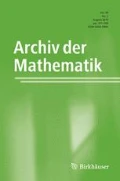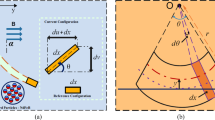Abstract
In this paper, we consider a truncated version of the Timoshenko beam model and we prove an inverse inequality in order to obtain the controllability of the total system. The present system is new in the control and stabilization setting according to recent contributions due to Almeida Júnior and Ramos (Z Angew Math Phys 68(145):31, 2017). The advantage here relies on mathematical results which do not depend on the classical condition between wave propagation velocities.

Similar content being viewed by others
References
Almeida Júnior, D.S., Ramos, A.J.A.: On the nature of dissipative Timoshenko systems at light of the second spectrum. Z. Angew. Math. Phys. 68(145), 31 (2017)
Almeida Júnior, D.S., Ramos, A.J.A., Santos, M.L., Miranda, L.G.R.: Asymptotic behavior of weakly dissipative Bresse–Timoshenko system on influence of the second spectrum of frequency. Z. Angew. Math. Mech. 98, 1–14 (2018)
Almeida Júnior, D.S., Elishakoff, I., Ramos, A.J.A., Miranda, L.G.R.: The hypothesis of equal wave speeds for stabilization of Bresse–Timoshenko system is not necessary anymore: the time delay cases. IMA J. Appl. Math. 84(4), 763–796 (2019)
Elishakoff, I.: An equation both more consistent and simpler than the Bresse–Timoshenko equation. In: Advances in Mathematical Modeling and Experimental Methods for Materials and Structures, Solid Mechanics and Its Applications, pp. 249–254. Springer, Berlin (2010)
Elishakoff, I., Kaplunov, J., Nolde, E.: Celebrating the centenary of Timoshenko’s study of effects of shear deformation and rotary inertia. Int. J. Solids Struct. 67(6) (2017)
Elishakoff, I., Hache, F., Challamel, N.: Variational derivation of governing differential equations for truncated version of Bresse–Timoshenko beams. J. Sound Vib. 435, 409–430 (2018)
Glowinski, R., Li, C.H., Lions, J.L.: A numerical approach to the exact boundary controllability of the wave equation. I. Dirichlet controls: description of the numerical methods. Japan J. Appl. Math. 103, 1–76 (1990)
Ingham, A.E.: Some trigonometrical inequalities with applications to the theory of series. Math. Z. 41, 367–379 (1936)
Graff, K.F.: Wave Motion in Elastic Solids. Dover Publication, New York (1991)
Komornik, V.: Exact Controllability and Stabilization: The Multiplier Method. Wiley, Wiley (1994)
Lions, J.L.: Contrôlabilité exacte, perturbations et stabilisation de systèmes distribués. Tome 1. Contrôlabilité exacte. Masson, RMA8 (1988)
Manevich, A., Kolakowski, Z.: Free and forced oscillations of Timoshenko beam made of viscoelastic material. J. Theor. Appl. Mech. 49(1), 3–16 (2011)
Nesterenko, V.V.: A theory for transverse vibrations of the Timoshenko beam. J. Appl. Math. Mech. 57, 669–677 (1993)
Traill-Nash, R.W., Collar, A.R.: The effects of shear flexibility and rotatory inertia on the bending vibrations of beams. Q. J. Mech. Appl. Math. 6, 186–222 (1953)
Timoshenko, S.P.: On the correction for shear of the differential equation for transverse vibrations of prismatic bars. Philos. Mag. 6(41/245), 744–746 (1921)
Youssef, W.: Contrôle et stabilisation de systèmes élastiques couplés. Ph.D. Thesis, University of Metz (2009)
Acknowledgements
The authors are grateful to the referee for his/her constructive remarks, which have enhanced the presentation of this paper.
Funding
A.J.A. Ramos thanks the CNPq for financial support through the projects: “Asymptotic stabilization and numerical treatment for carbon nanotubes” - CNPq Grant 310729/2019-0.
D.S. Almeida Júnior thanks CNPq and CAPES/INCTMAT/LNCC for support through Grants 310423/2016-3 and 88887.351763/2019-00, respectively. L.G.R. Miranda thanks the Capes for financial scholarship support through Grant 99244292220.
Author information
Authors and Affiliations
Corresponding author
Additional information
Publisher's Note
Springer Nature remains neutral with regard to jurisdictional claims in published maps and institutional affiliations.
Rights and permissions
About this article
Cite this article
Ramos, A.J.A., Júnior, D.S.A. & Miranda, L.G.R. An inverse inequality for a Bresse–Timoshenko system without second spectrum of frequency. Arch. Math. 114, 709–719 (2020). https://doi.org/10.1007/s00013-020-01452-5
Received:
Published:
Issue Date:
DOI: https://doi.org/10.1007/s00013-020-01452-5



